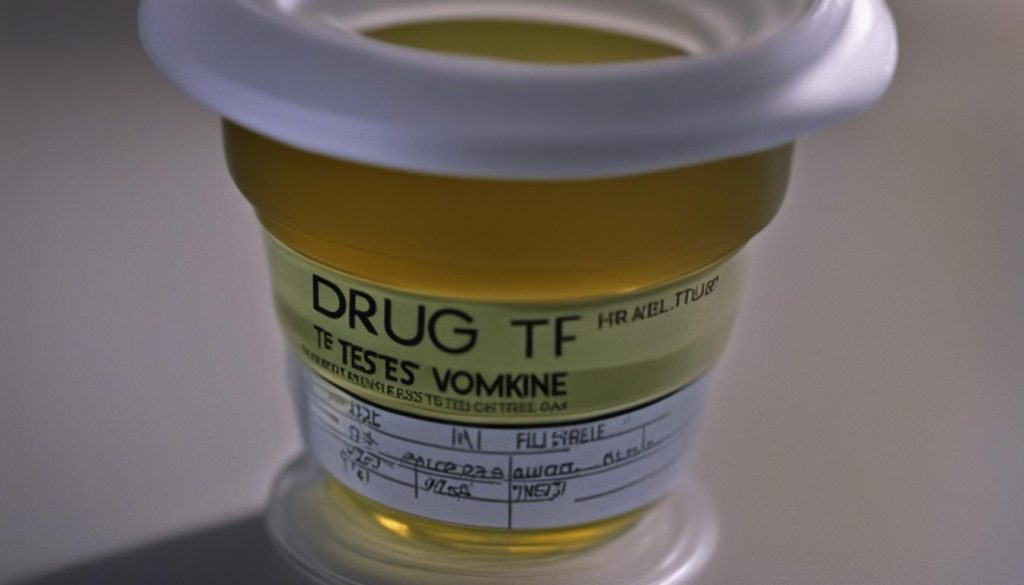
When it comes to drug tests, understanding the duration of detection and effective methods to pass them is crucial. In particular, urine tests are one of the most common methods used by employers to detect marijuana use. These tests can reveal marijuana consumption for different durations depending on the frequency of use. Whether you are an occasional user or a multiple daily user, knowing how long marijuana can be detected in your urine is essential.
Employers often set a cut-off level of 50 ng/ml to determine positive results. This means that if the concentration of marijuana metabolites in your urine sample is below this threshold, the test will show a negative result. However, it’s important to note that urine tests detect nonactive metabolites, not the psychoactive ingredient THC itself.
To increase your chances of passing a urine drug test, there are a few methods you can try. Diluting the concentration of drugs in your urine sample below the threshold of detection is one approach. This can be achieved by increasing fluid intake and urine flow. However, it’s important to note that tampering with the sample or using adulterants is not recommended and can carry risks.
While urine tests are the most common method of drug testing, it’s worth mentioning that blood and hair tests can also detect marijuana use. Blood tests detect THC and other cannabinoids in the bloodstream but are rarely used due to the rapid elimination of THC. Hair tests, on the other hand, have a longer detection window of up to 90 days but may be less reliable in identifying occasional use.
Key Takeaways:
- Urine tests can detect marijuana for different durations depending on the frequency of use.
- Employers often use a cut-off level of 50 ng/ml to determine positive results.
- Increasing fluid intake and urine flow can help dilute the concentration of drugs in the urine sample.
- Tampering with the sample or using adulterants is not recommended.
- Blood and hair tests are alternative methods of drug testing.
How to Pass a Urine Drug Test: Tips and Tricks
Passing a urine drug test can be a crucial step in securing employment or maintaining certain privileges. While it is always best to avoid marijuana consumption altogether, there are some tips and tricks that may increase your chances of passing the test.
Firstly, it is important to stay properly hydrated. Drinking plenty of water in the days leading up to the test can help dilute the concentration of drugs in your urine sample. Additionally, try to fill your bladder before providing the sample, as this can further help dilute any drug metabolites present.
Taking vitamin B2 supplements can also be beneficial. These supplements can color your urine a vibrant yellow, which can make it appear less diluted. It is important to note that hydration and supplementation cannot guarantee a negative result, but they may improve your chances.
Lastly, it is generally recommended to provide a urine sample later in the day rather than in the morning. This is because drug metabolites tend to build up during sleep, and providing a sample later in the day may result in lower concentrations of these metabolites.
While these tips and tricks may be helpful, it is important to note that none of them are foolproof. The best way to ensure a negative result is to abstain from marijuana use. It is also important to understand that tampering with the sample or using adulterants can have serious consequences and is not recommended.
When facing a urine drug test, it is essential to approach the situation with caution and adhere to legal guidelines. Consulting with a healthcare professional or legal expert can provide valuable insight into the specific requirements and best practices for your situation.
Understanding Urine Drug Test Thresholds and Detection Methods
Urine drug tests are commonly used to detect marijuana use, with a cut-off threshold of 50 ng/ml for the THC-COOH metabolite. These tests work by analyzing the presence and concentration of metabolites in the urine sample. Initial screenings are typically performed using immunoassay tests, which are highly sensitive but can yield false positives or false negatives. If a positive result is obtained in the initial screening, a confirmatory test such as gas chromatography/mass spectrometry (GC/MS) is conducted for greater precision and accuracy.
The accuracy of the initial screening is around 95-97%, while the confirmatory test is virtually 100% accurate. It is important to note that the urine test detects nonactive metabolites of THC and not the psychoactive THC itself. Other methods of marijuana detection, such as blood, saliva, and hair tests, are also available, but urine tests are the most commonly used due to their practicality and cost-effectiveness.
“Urine drug tests for marijuana usually have a cut-off threshold of 50 ng/ml for the THC-COOH metabolite.”
Comparison Between Urine, Blood, Saliva, and Hair Tests
| Test Method | Detection Window | Advantages | Limitations |
|---|---|---|---|
| Urine Test | Up to 30 days | Cost-effective and widely available | Potential for false positives/negatives |
| Blood Test | Up to 24 hours | Accurate for recent use | Not commonly used due to short detection window |
| Saliva Test | Up to 48 hours | Non-invasive and easy to administer | Less reliable for detecting previous use |
| Hair Test | Up to 90 days | Long detection window | Possible influence from external factors |
While urine tests have their limitations, they remain the standard method for detecting marijuana use. The choice of testing method depends on various factors, including the purpose of the test, the desired detection window, and the reliability of the specific method. It is essential to understand the thresholds and detection methods for urine tests to make informed decisions and interpretations regarding marijuana use.
Factors Affecting THC-COOH Elimination and Detection Time
Elimination of THC-COOH, the primary metabolite of marijuana, from the body can be influenced by several factors, resulting in variations in the detection time. Understanding these factors is crucial for individuals undergoing urine drug tests.
Frequency of Marijuana Use
The frequency of marijuana use is a key determinant of how long THC-COOH remains detectable in urine. Higher frequency and regular use can extend the detection window, as THC-COOH accumulates in the body over time. Occasional users who consume marijuana infrequently will have shorter detection periods compared to those who use it daily.
Dosage and Potency
The amount of cannabis consumed and the potency of the product can also affect the detection time. Higher doses and more potent strains can result in higher levels of THC and THC-COOH in the body, leading to an extended detection window.
Metabolism Rate and Body Mass Index (BMI)
Individual differences in metabolism rate and BMI can impact the elimination of THC-COOH. People with faster metabolisms tend to eliminate the metabolite more quickly, resulting in a shorter detection period. Conversely, individuals with higher BMI or more body fat may retain THC metabolites longer due to their fat-soluble nature.
Hydration Levels and Physical Activity
Hydration levels and physical activity can also influence the elimination of THC-COOH. Adequate hydration helps flush out toxins from the body, potentially speeding up the elimination process. Regular physical activity, such as exercise, can also support the body’s natural detoxification mechanisms.
| Factors | Impact on THC-COOH Elimination |
|---|---|
| Frequency of Use | Higher frequency extends detection time |
| Dosage and Potency | Higher amounts and potency result in longer detection windows |
| Metabolism Rate | Faster metabolism leads to quicker elimination |
| Body Mass Index (BMI) | Higher BMI may prolong detection period |
| Hydration Levels | Adequate hydration supports elimination |
| Physical Activity | Regular exercise can aid in elimination |
It is important to note that while these factors can affect the detection time, there is no guaranteed method to expedite the elimination of THC-COOH. The body’s natural processes dictate the rate at which the metabolite is cleared. Additionally, no specific foods or supplements have been scientifically proven to accelerate THC-COOH removal.
Understanding the factors influencing THC-COOH elimination can help individuals prepare for urine drug tests better. By considering these factors and adopting a healthy lifestyle, individuals may improve their chances of passing the test.
Understanding Cannabis Urine Test Detection Windows
When it comes to drug testing for marijuana, understanding the detection window is crucial. The length of time that cannabis can be detected in urine varies depending on several factors, including frequency of use, dosage, metabolism, and the type of cannabis consumed. Different strains of marijuana can also influence the detection window. Let’s explore the typical detection windows for cannabis urine tests:
Occasional users: Those who use marijuana up to three times a week can generally test positive for around 1-3 days after use.
Moderate users: Individuals who consume cannabis four to six times a month may test positive for approximately 5-7 days.
Regular users: Daily marijuana use can result in positive urine tests for up to 10-15 days or longer after cessation.
Heavy or chronic users: Individuals who consume marijuana multiple times a day may test positive for up to 30 days after stopping.

It’s important to note that these are general guidelines and individual variations can occur. Additionally, the method of consumption can also impact the detection window. For example, edibles tend to have a longer onset time compared to smoking or vaporizing, which may affect the detection of cannabis in urine.
Detoxification Methods and Their Effectiveness
When it comes to detoxification methods for passing a marijuana drug test, there are various techniques that claim to help eliminate THC-COOH from the body. However, the effectiveness of these methods lacks scientific confirmation. While maintaining a healthy lifestyle, including exercise and proper hydration, may support the body’s natural detoxification process, there are no specific foods or supplements proven to expedite the removal of THC-COOH. It’s important to be cautious and not rely solely on detox products or kits, as their efficacy may vary. It is always advisable to consult with a healthcare professional and follow legal guidelines when considering detoxification methods.
In recent years, the market has been flooded with numerous detox products and kits that promise quick results. These products often claim to flush out THC-COOH and help individuals pass a drug test. However, the scientific evidence supporting their effectiveness is lacking. Many of these products rely on diuretics and other substances that may increase urine output, but these methods can be risky and may not guarantee a successful outcome.
When it comes to detoxification methods, it’s important to understand that the body’s metabolism and elimination of THC-COOH are influenced by various factors such as frequency of use, dosage, metabolism rate, and body mass index (BMI). These factors can significantly impact how long THC-COOH remains detectable in urine. While some methods claim to speed up the body’s detoxification process, there is no scientific evidence to support their effectiveness.
Ultimately, the best approach to passing a drug test is to abstain from marijuana use and allow the body’s natural elimination process to take its course. While it may be tempting to try detox products or methods, it’s important to approach them with caution and be aware of their limitations. Consulting with a healthcare professional and understanding the legal considerations surrounding drug testing is crucial for making informed decisions.
Legal Considerations and Challenges Regarding Drug Testing
When it comes to drug testing in the workplace, there are important legal considerations and challenges that both employers and employees need to be aware of. Drug testing is a common practice in many industries, but it is not without its legal complexities. Privacy concerns and the potential for discrimination are among the key issues that arise in drug testing scenarios.
Employers generally have the right to implement drug testing programs as a means to ensure a safe and drug-free work environment. However, the legality of drug testing can vary depending on local labor laws and regulations. Prospective employees generally do not have a legal right to challenge pre-employment drug tests, as long as the tests are carried out within the boundaries of the law.
Yet, already employed individuals may have certain rights when it comes to drug testing. Some jurisdictions restrict drug testing to safety-sensitive positions, while others have specific guidelines in place to protect employees from unjust or discriminatory testing practices. It is essential for both employers and employees to understand the legal landscape surrounding drug testing in their respective areas and consult with legal professionals if necessary.
Drug testing in the workplace can raise privacy issues and may be subject to legal restrictions. Both employers and employees need to be aware of the legal considerations and challenges surrounding drug testing to ensure compliance and protect individual rights.
Another legal consideration in drug testing relates to medical marijuana laws. The use of cannabis for medicinal purposes is legal in many states, but employees who use medical marijuana may face unique challenges in the workplace. While some state laws may provide protections for employees who are registered medical marijuana patients, there can still be conflicts between state laws and federal regulations, as marijuana remains illegal under federal law. It is important for both employers and employees to navigate these legal complexities and understand their rights and obligations in the context of medical marijuana use.

| Legal Considerations | Challenges |
|---|---|
| Privacy concerns | Conflict between state and federal laws |
| Potential for discrimination | Ensuring compliance with local labor laws |
| Medical marijuana laws | Protecting individual rights |
In conclusion, drug testing in the workplace presents legal considerations and challenges that must be carefully navigated by both employers and employees. Privacy concerns, potential discrimination, and conflicts between state and federal laws are among the key issues to be addressed. Understanding the legal landscape and consulting with legal professionals can help ensure compliance and protect individual rights in drug testing scenarios.
Alternative Drug Testing Methods: Blood and Hair Tests
When it comes to drug testing for marijuana, urine tests are the most common method used. However, there are alternative testing methods that can provide valuable insights. Blood tests and hair tests can offer different perspectives on detecting cannabis use.
Compared to urine tests, blood tests have a shorter detection window for THC and other cannabinoids. THC is rapidly eliminated from the bloodstream, making blood tests less reliable for detecting past marijuana use. Therefore, blood tests are rarely used solely for marijuana detection.
On the other hand, hair tests have a longer detection window compared to urine tests. Hair tests can detect drug use for up to 90 days, making them a useful tool for identifying long-term patterns of marijuana consumption. However, it’s important to note that hair tests may not be as effective in identifying occasional use.

Table: Comparison of Drug Testing Methods
| Drug Testing Method | Detection Window | Reliability for Marijuana Detection |
|---|---|---|
| Urine Test | 1-30 days depending on frequency of use | Most common method, detects nonactive metabolites |
| Blood Test | Up to 24 hours | Rarely used for marijuana detection, rapid elimination of THC |
| Hair Test | Up to 90 days | Long detection window, effective for identifying long-term use |
While urine tests remain the primary method for drug testing, understanding the alternatives can provide a more comprehensive view. Blood tests offer insight into recent drug use, while hair tests can reveal a person’s drug history over a longer period. By considering the advantages and limitations of each testing method, employers and individuals can make informed decisions regarding drug testing protocols.
Conclusion
After discussing the duration of detection, the factors affecting elimination, and the different testing methods, we can conclude that passing a drug test for marijuana requires careful consideration and preparation. Understanding the detection window and how long THC-COOH can be detected in urine is essential for planning ahead. Factors such as frequency of use, metabolism, and hydration levels can affect the rate at which THC-COOH is eliminated from the body.
While dilution methods, hydration, exercise, and maintaining a healthy lifestyle may support the elimination process, there are no proven foods or supplements that guarantee faster removal of THC-COOH. It is crucial to be aware of legal considerations and challenges surrounding drug testing, as well as the limitations and accuracy of different testing methods. Consulting with healthcare professionals and adhering to legal guidelines is always recommended when facing a drug test.
In conclusion, passing a drug test for marijuana requires knowledge and preparation. By understanding the detection window, factors affecting elimination, and legal considerations, individuals can make informed decisions and take appropriate steps to increase their chances of passing a drug test. Remember to follow legal guidelines, consult with professionals when needed, and prioritize a healthy lifestyle to support the elimination process.
FAQ
How long can marijuana be detected in a urine test?
The detection window for marijuana in a urine test varies depending on the frequency of use. Occasional users may test positive for 1-5 days, regular users for 1-3 weeks, and multiple daily users for 4-6 weeks.
What is the cut-off level for a positive result in a urine drug test?
Employers often use a cut-off level of 50 ng/ml to determine positive results in a urine drug test.
Do urine tests detect THC, the psychoactive ingredient in marijuana?
No, urine tests detect nonactive metabolites of THC, not the psychoactive ingredient itself.
Can drinking more water help pass a urine drug test?
Increasing fluid intake and urine flow can help dilute the concentration of drugs in the urine sample, potentially helping to pass the test.
Can passive smoking be used as an excuse for a positive urine test result?
No, passive smoking is not generally accepted as a valid reason for a positive urine test result.
Are there any risks associated with tampering with a urine sample or using adulterants?
Yes, tampering with a urine sample or using adulterants can carry risks and is not recommended.
Are blood and hair tests used for drug testing?
Blood and hair tests can also detect marijuana use, but urine tests are the most common method.
How long can marijuana be detected in a hair test?
Hair tests can detect marijuana use for up to 90 days.
Can specific foods or supplements help pass a urine drug test?
There is no scientific evidence to support the effectiveness of specific foods or supplements in passing a urine drug test.
What legal considerations should be taken into account regarding drug testing?
It is important to understand the legal landscape regarding drug testing in your area and consult with legal professionals if you believe you are being unjustly tested.
















